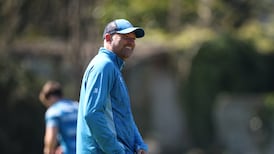I had the pleasure of a pitch side ramble pre-kick-off on Saturday. Standing feet away from the Australian back line was a pretty sobering sight. I’m told fullback Israel Folau has size 13 feet at the end of his 6ft 4in frame.
I'm not sure is it their technical training or Porter's Diamond that has them playing rugby as they do. Michael Porter outlined in The Competitive Advantage of Nations his belief as to how how certain industries become competitive in certain locations.
Playing the All Blacks regularly might have that effect on your game. Playing Richie McCaw regularly might have that effect on your breakdown technique.
Up here in Six Nations land, a relieving kick to touch from your outhalf is applauded by the crowd; not so in Sydney.
Australia, similar to New Zealand, have many startling players such as Folau but their "average" players are far superior to our legends.
Simply phenomenal
All Black number eight Kieran Read is no Zinzan Brook and unlikely to drop goals in the Aviva next Saturday but he is simply phenomenal.
This gulf is often mistaken for magic ability but it is their ability to execute the basics at full flight that impresses.
With time running out on Saturday sub prop Jack McGrath got on to a great ball, deep in Wallaby territory. In heavy traffic he did very well, carrying before eventually going to ground. No issues there, but All Black props Tony Woodcock or Owen Franks would not have gone to deck and the ball would have remained alive; ditto Wallabies James Slipper and Sekope Kepu.
Small margins, possibly, but spilling clean lineout catches; missing touches; missing penalty kicks; choosing to go down the line with 20 minutes to go while spurning three points; box-kicking into Folau’s bread basket; and not converting scoring opportunities all add up for an Irish side that is obviously trying to rid itself of the shackles of previous styles.
Many of Ireland’s players were simply not good enough on Saturday but I’m of the opinion that for the new management messages to bed in and eventually bear fruit we need more exposure to Porter’s Diamond.
Having observed their warm-up drills while pitchside on Saturday, it was no coincidence Australia’s tries all came from this warm-up.
Quade Cooper would take from Will Genia and drift slightly with the pass. All the while his 11, 12, 13, 14 and 15 would sprint into a very flat line all expecting to receive. The skill, the outrageous skill, is Cooper's ability to loiter laterally with ball in both hands as he owls his head infield to survey the gold line of attackers before selecting one, generally around the outside third channel of the pitch.
Green heat
It was one thing to do this unopposed in warm-up drills but in the green heat of an Irish defensive line, Cooper looked laid back and almost sleepy in repeating ad nauseam the warm-up drill.
For his own try, he managed the same routine but chose not to pass! The iron is they continuously ran the same lines and options with minimal variation; and Ireland were unable to cope.
For Michael Hooper’s first try Australia ran a screen as Moore pulled back to Cooper, who fired wide. In essence, Australia worked hard to create 3 v 2 or even 3 v 3 out wide, on the understanding that Ireland would become muddled and unable to cope with the angles and pace.
On Friday, I dedicated much of my piece to Wallaby openside Hooper. From close inspection in the Aviva there’s enough to fill a book.
I flirted with the idea on Friday that he visualises the environment before it unfolds and hence pounces as it does.
He works hard to get ahead of the ball and thus affords his support players a new target deeper in the Irish breakdown. They then funnel to him, minimising the "gate" effect.
Ben Mowen effect
Add to that the Ben Mowen effect. He arrived to the fringe of breakdowns where I could actually read his thoughts as he surveyed the scene. Then like a coiled pinball, he would fly out of the pillar position to attack the halfbacks.
Paul O’Connell fell foul of Mowen’s intervention and spilled the ball.
These acts happened far too often to be a happy coincidence and must have been perfected by many hours of what Daniel Coyle calls deep practice.
This deep practice paid off spectacularly when Stephen Moore and Cooper’s worlds collided. Cooper drifted across, ball in both hands fixing three defenders, with Brian O’Driscoll stepping in. All the while, Moore ran a brilliant line to take, carry and give winger Nick Cummins his try.
Moore’s knowledge of Cooper’s style was the key, ensuring he anticipated the opportunity Cooper was affording him and adjusting his pace, line and angle to maximise. Could our frontrowers match Moore or would they hit the deck?
With a monster match ahead of us this Sunday it will take very deep practice to bridge the gap, but be patient, as it will also take 10,000 hours.
liamtoland@yahoo.com












